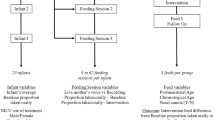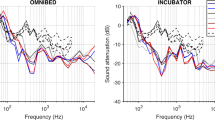Abstract
Objective
Quantify NICU speech exposure over multiple days in relation to NICU care practices.
Methods
Continuous measures of speech exposure were obtained for preterm infants (n = 21; 12 M) born <34 weeks gestational age in incubators (n = 12) or open cribs (n = 9) for 5–14 days. Periods of care (routine, developmental) and delivery source (family, medical staff, cuddler) were determined through chart review.
Results
Infants spent 13% of their time in Care, with >75% of care time reflecting developmental care. Speech counts were higher during care than no care, for mature vs. immature infants, and for infants in open cribs vs. incubators. Family participation in care ranged widely, with the highest speech counts occurring during periods of intentional voice exposure.
Conclusions
Care activities represent a small portion of NICU experiences. Speech exposure during Developmental Care, especially with intentional voice exposure, may be an important source of stimulation. Implications for care practices are discussed.
This is a preview of subscription content, access via your institution
Access options
Subscribe to this journal
Receive 12 print issues and online access
$259.00 per year
only $21.58 per issue
Buy this article
- Purchase on Springer Link
- Instant access to full article PDF
Prices may be subject to local taxes which are calculated during checkout



Similar content being viewed by others
References
Walsh MC, Bell EF, Kandefer S, Saha S, Carlo WA, D’angio CT, et al. Neonatal outcomes of moderately preterm infants compared to extremely preterm infants. Pediatr Res. 2017;82:297–304. https://www.nature.com/articles/pr201746
Mikkola K, Ritari N, Tommiska V, Salokorpi T, Lehtonen L, Tammela O, et al. Neurodevelopmental outcome at 5 years of age of a national cohort of extremely low birth weight infants who were born in 1996-1997. Pediatrics. 2005;116:1391–400. https://pediatrics.aappublications.org/content/116/6/1391.long
Allen MC. Neurodevelopmental outcomes of preterm infants. Curr Opin Neurol. 2008;21:123–8. https://insights.ovid.com/crossref?an=00019052-200804000-00004
Anderson P, Doyle LW. Neurobehavioral outcomes of school-age children born extremely low birth weight or very preterm in the 1990s. J Am Med Assoc. 2003;289:3264–72. https://jamanetwork.com/journals/jama/fullarticle/196802
Aylward GP. Cognitive and neuropsychological outcomes: More than IQ scores [Internet]. Vol. 8, Mental Retardation and Developmental Disabilities Research Reviews. 2002 [cited 2020 Feb 7]. p. 234–40. Available from: https://onlinelibrary.wiley.com/doi/pdf/10.1002/mrdd.10043
Bhutta AT, Cleves MA, Casey PH, Cradock MM, Anand KJS. Cognitive and behavioral outcomes of school-aged children who were born preterm: a meta-analysis. J Am Med Assoc. 2002;288:728–37. https://jamanetwork.com/journals/jama/fullarticle/195181
Johnson S, Hennessy E, Smith R, Trikic R, Wolke D, Marlow N. Academic attainment and special educational needs in extremely preterm children at 11 years of age: The EPICure study. Arch Dis Child Fetal Neonatal Ed. 2009;94. https://fn.bmj.com/content/94/4/F283.long
Luu TM, Ment LR, Schneider KC, Katz KH, Allan WC, Vohr BR. Lasting effects of preterm birth and neonatal brain hemorrhage at 12 years of age. Pediatrics. 2009;123:1037–44. https://www.ncbi.nlm.nih.gov/pmc/articles/PMC2651566/
Foster-Cohen S, Edgin JO, Champion PR, Woodward LJ. Early delayed language development in very preterm infants: Evidence from the MacArthur-Bates CDI. J Child Lang. 2007;34:655–75. https://www.researchgate.net/publication/6018530_Early_delayed_language_development_in_very_preterm_infants_Evidence_from_the_MacArthur-Bates_CDI
Guarini A, Sansavini A, Fabbri C, Alessandroni R, Faldella G, Karmiloff-Smith A. Reconsidering the impact of preterm birth on language outcome. Early Hum Dev. 2009;85:639–45. https://www.sciencedirect.com/science/article/pii/S0378378209001790?via%3Dihub
Stolt S, Klippi A, Launonen K, Munck P, Lehtonen L, Lapinleimu H, et al. Size and composition of the lexicon in prematurely born very-low-birth-weight and full-term Finnish children at two years of age. J Child Lang. 2007;34:283–310. https://www.researchgate.net/publication/6294499_Size_and_composition_of_the_lexicon_in_prematurely_born_very-low-birth-weight_and_full-term_Finnish_children_at_two_years_of_age
Jansson-Verkasalo E, Valkama M, Vainionpää L, Pääkkö E, Ilkko E, Lehtihalmes M. Language development in very low birth weight preterm children: a follow-up study. Folia Phoniatr Logop. 2004;56:108–19. https://www.karger.com/Article/FullText/76062
Pietz J, Peter J, Graf R, Rauterberg-Ruland I, Rupp A, Sontheimer D, et al. Physical growth and neurodevelopmental outcome of nonhandicapped low-risk children born preterm. Early Hum Dev. 2004;79:131–43. https://www.researchgate.net/publication/8387114_Physical_growth_and_neurodevelopmental_outcome_of_nonhandicapped_low-risk_children_born_preterm
Feldman HM, Lee ES, Yeatman JD, Yeom KW. Language and reading skills in school-aged children and adolescents born preterm are associated with white matter properties on diffusion tensor imaging. Neuropsychologia. 2012;50:3348–62. https://www.ncbi.nlm.nih.gov/pmc/articles/PMC3631607/
Foster-Cohen SH, Friesen MD, Champion PR, Woodward LJ. High prevalence/low severity language delay in preschool children born very preterm. J Dev Behav Pediatr. 2010;31:658–67. https://insights.ovid.com/crossref?an=00004703-201010000-00005
Menting B, Van Lier PAC, Koot HM. Language skills, peer rejection, and the development of externalizing behavior from kindergarten to fourth grade. J Child Psychol Psychiatry Allied Discip. 2011;52:72–9. https://pascal-francis.inist.fr/vibad/index.php?action=getRecordDetail&idt=23779656
Catts HW, Fey ME, Tomblin JB, Zhang X. A longitudinal investigation of reading outcomes in children with language impairments. J Speech Lang Hear Res. 2002;45:1142–57. http://pubs.asha.org/doi/10.1044/1092-4388%282002/093%29
Bakken TE, Roddey JC, Djurovic S, Akshoomoff N, Amaral DG, Bloss CS, et al. Association of common genetic variants in GPCPD1 with scaling of visual cortical surface area in humans. Proc Natl Acad Sci USA. 2012;109:3985–90. https://www.pnas.org/content/109/10/3985.long
Pineda RG, Neil J, Dierker D, Smyser CD, Wallendorf M, Kidokoro H, et al. Alterations in brain structure and neurodevelopmental outcome in preterm infants hospitalized in different neonatal intensive care unit environments. J Pediatr. 2014;164. https://www.ncbi.nlm.nih.gov/pmc/articles/PMC3872171/
Caskey M, Stephens B, Tucker R, Vohr B. Adult talk in the NICU With preterm infants and developmental outcomes. Pediatrics. 2014;133:e578–84. https://pediatrics.aappublications.org/content/133/3/e578.long
Pineda R, Bender J, Hall B, Shabosky L, Annecca A, Smith J. Parent participation in the neonatal intensive care unit: Predictors and relationships to neurobehavior and developmental outcomes. Early Hum Dev. 2018;117:32–8. https://www.ncbi.nlm.nih.gov/pmc/articles/PMC5856604/
Scala M, Seo S, Lee-Park J, McClure C, Scala M, Palafoutas JJ, et al. Effect of reading to preterm infants on measures of cardiorespiratory stability in the neonatal intensive care unit. J Perinatol. 2018;38:1536–41. https://doi.org/10.1038/s41372-018-0198-4. Available from
Doheny L, Hurwitz S, Insoft R, Ringer S, Lahav A. Exposure to biological maternal sounds improves cardiorespiratory regulation in extremely preterm infants. J Matern Neonatal Med. 2012;25:1591–4. https://www.tandfonline.com/doi/abs/10.3109/14767058.2011.648237?journalCode
Zimmerman E, Keunen K, Norton M, Lahav A. Weight gain velocity in very low-birth-weight infants: Effects of exposure to biological maternal sounds. Am J Perinatol. 2013;30:863–70. https://www.thieme-connect.com/products/ejournals/abstract/10.1055/s-0033
Chorna OD, Slaughter JC, Wang L, Stark AR, Maitre NL. A pacifier-activated music player with mother’s voice improves oral feeding in preterm infants. Pediatrics. 2014;133:462–8. https://www.ncbi.nlm.nih.gov/pmc/articles/PMC3934339/
Krueger C, Parker L, Chiu SH, Theriaque D. Maternal voice and short-term outcomes in preterm infants. Dev Psychobiol. 2010;52:205–12. https://www.ncbi.nlm.nih.gov/pmc/articles/PMC3650487/
Pineda R, Durant P, Mathur A, Inder T, Wallendorf M, Schlaggar BL. Auditory exposure in the neonatal intensive care unit: room type and other predictors. J Pediatr. 2017;183:56–66.e3. https://www.sciencedirect.com/science/article/pii/S0022347616315670?via%3Dihub
Franck LS, O’Brien K The evolution of family-centered care: from supporting parent-delivered interventions to a model of family integrated care. Birth Defects Research. 2019;111:1044–59. https://onlinelibrary.wiley.com/doi/abs/10.1002/bdr2.1521
Parra J, de Suremain A, Berne Audeoud F, Ego A, Debillon T. Sound levels in a neonatal intensive care unit significantly exceeded recommendations, especially inside incubators. Acta Paediatr Int J Paediatr [Internet]. 2017;106:1909–14. https://onlinelibrary.wiley.com/doi/abs/10.1111/apa.13906
Marik PE, Fuller C, Levitov A, Moll E. Neonatal incubators: a toxic sound environment for the preterm infant? Pediatr Crit Care Med. 2012;13:685–9. https://insights.ovid.com/pubmed?pmid=22791088
Shellhaas RA, Burns JW, Barks JDE, Hassan F, Chervin RD. Maternal voice and infant sleep in the neonatal intensive care unit. Pediatrics. 2019;144:e20190288 https://pediatrics.aappublications.org/content/144/3/e20190288
Sigurdson K, Mitchell B, Liu J, Morton C, Gould JB, Lee HC, et al. Racial/ethnic disparities in neonatal intensive care: a systematic review. Pediatrics. 2019;144:e20183114. https://pediatrics.aappublications.org/content/144/2/e20183114.long
Fernald A, Marchman VA, Weisleder A. SES differences in language processing skill and vocabulary are evident at 18 months. Dev Sci. 2013;16:234–48. https://www.ncbi.nlm.nih.gov/pmc/articles/PMC3582035/
Ford M, Baer CT, Xu D, Yapanel U, Gray S. The LENA TM language environment analysis system: audio specifications of the DLP-0121. LENA Foundation Technical Report. 2008. p. 8 https://pdfs.semanticscholar.org/44d1/08871b090c846d40fb1c096cdd279a627c2c.pdf
Lester BM, Salisbury AL, Hawes K, Dansereau LM, Bigsby R, Laptook A, et al. 18-Month follow-up of infants cared for in a single-family room neonatal intensive care unit. J Pediatr. 2016;177:84–9. https://www.jpeds.com/article/S0022-3476(16)30498-X/fulltext
Mehl MR, Vazire S, Ramírez-Esparza N, Slatcher RB, Pennebaker JW. Are women really more talkative than men? Science. 2007;317:82. https://science.sciencemag.org/content/317/5834/82.abstract
Best K, Bogossian F, New K. Language exposure of preterm infants in the neonatal unit: a systematic review. Neonatology. 2018;114:261–76. https://www.karger.com/Article/FullText/489600
Fricke S, Bowyer-Crane C, Haley AJ, Hulme C, Snowling MJ. Efficacy of language intervention in the early years. J Child Psychol Psychiatry Allied Discip. 2013;54:280–90. https://onlinelibrary.wiley.com/doi/full/10.1111/jcpp.12010
Funding
Grant funding in support of this project was provided by the Maternal and Children’s Health Research Institute at Stanford University and a Pathway to Independence Award to KET 5K99HD084749 from National Institutes of Health. Donation of Starling devices was provided by Versame, Inc.
Author information
Authors and Affiliations
Contributions
All authors have met the requirements of Journal of Perinatology for authorship. MLS, VAM and KET contributed to conception, design, data analysis, drafting or revising the article and final approval. CG and CG were responsible for acquisition of data, some analysis and final approval of manuscript.
Corresponding author
Ethics declarations
Conflict of interest
The authors declare that they have no conflict of interest.
Additional information
Publisher’s note Springer Nature remains neutral with regard to jurisdictional claims in published maps and institutional affiliations.
Supplementary information
Rights and permissions
About this article
Cite this article
Scala, M.L., Marchman, V.A., Godenzi, C. et al. Assessing speech exposure in the NICU: Implications for speech enrichment for preterm infants. J Perinatol 40, 1537–1545 (2020). https://doi.org/10.1038/s41372-020-0672-7
Received:
Revised:
Accepted:
Published:
Issue Date:
DOI: https://doi.org/10.1038/s41372-020-0672-7



